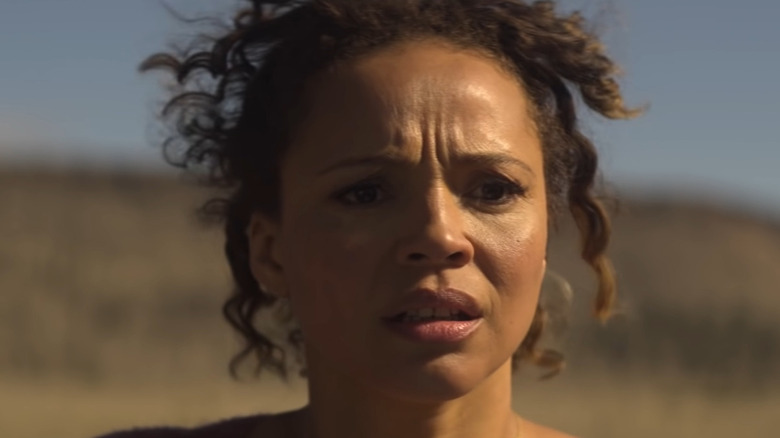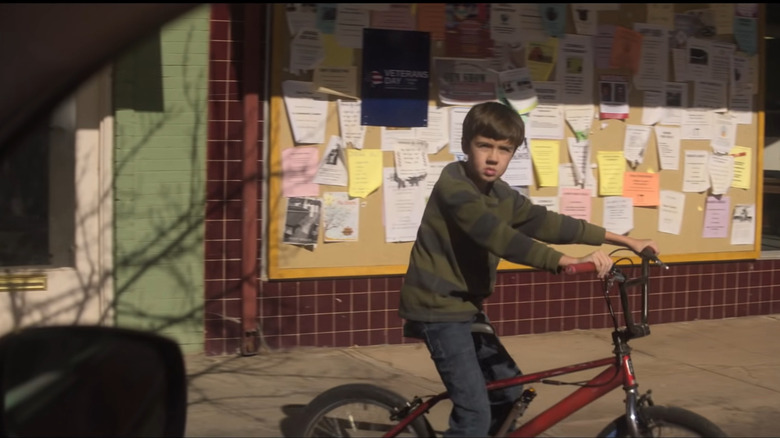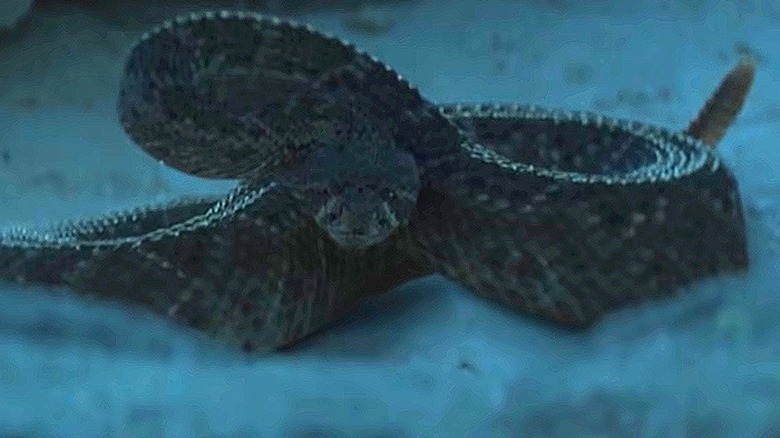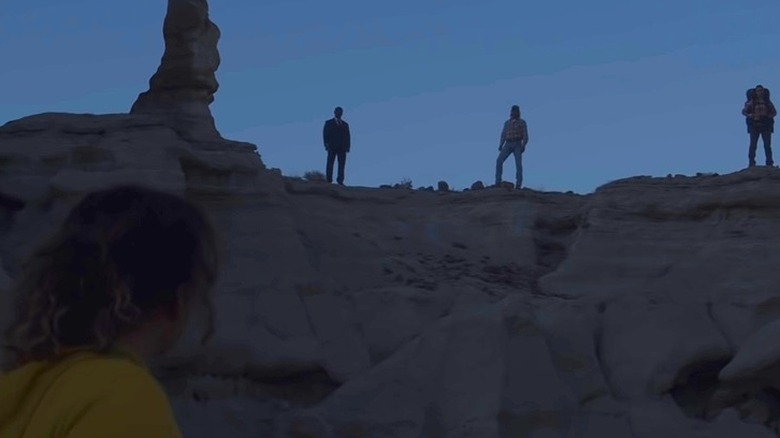The Ending Of Rattlesnake Explained
In 2019, Netflix released the horror thriller, "Rattlesnake." Starring Carmen Ejogo, Theo Rossi, and Appy Pratt, the film follows a mother (Ejogo) who, after a stranger saves her daughter (Pratt) from a rattlesnake bite, finds herself in a difficult position when she must find a way to pay off her devious debts.
Director Zak Hilditch, who also helmed the 2017 Netflix Stephen King adaptation "1922," brings a grounded human element to the film that blends organically with the bizarre premise, making for an intriguing horror venture of the small-scale, low-budget variety. "Rattlesnake" was not, sadly, the most well-received by the majority of critics. On Rotten Tomatoes, the film only has a 30% Tomatometer critic's score, with the critical census saying that "this disposable thriller [...] lacks the cleverness or specificity to give its thin conceit any bite."
In a way, saying that the film isn't specific enough is actually one of its strengths. "Rattlesnake" doesn't concern itself with always giving its viewers all the answers, allowing the audience to interpret the journey however they see it. It's no avant-garde art film by any means, but it nevertheless has a lot more to offer than your typical straightforward thriller might aim for. And by the ending, especially, you are left with a lot of questions.
So, let's sink our teeth into "Rattlesnake" and try to wrap our heads around its plot, themes, and ending.
Getting through the rain to find the rainbow
The film centers around single mom Katrina, who is taking her daughter, Clara, on a road trip to Oklahoma. But it seems that there's more to their venture than a simple getaway. We can assume from the self-help tapes she is listening to on their trip that they could be trying to escape from an unhappier life elsewhere. However, after Katrina has to change their tire on the side of the road, Clara gets bit by a rattlesnake. Katrina finds a woman in a lonesome trailer, who agrees to heal her daughter. After fixing the tire and Clara seems healed, Katrina takes her to the nearest town, Tulia, Texas, to get additional help at a hospital.
From here, Katrina learns that her "payment" for saving Clara's life is another soul to take her place. She can either kill herself or someone else by sunset — otherwise, her daughter will die.
At first, this seems like a strange occurrence, but as Katrina uncovers more about the town, we learn that there is more to it. Tulia goes through an experience straight out of an episode of "The Twilight Zone," wherein individuals go through insurmountable challenges to find salvation. This is even more evident when a strange dark figure shows up in several photos Katrina discovers of past victims. Those who fail to pay their debt are forced to relive their deaths over and over again. Katrina's hopes of a peaceful life are now challenged by Tulia. Her limits will be tested to see just how hard she will fight for her and her daughter's happiness.
Sneaky snake or serpent savior?
In possibly the biggest plot twist since "Star Wars: The Empire Strikes Back," the movie "Rattlesnake" does, indeed, have a rattlesnake in it.
Okay, in all seriousness, the serpent's appearance plays significantly into the film's symbolism. As we mentioned before, Tulia is like a judgment zone for any passersby, to see just how far they will go to reach their goals. If we look at Tulia as some form of hell, the snake could be a devil. Much like the story of Adam and Eve, the snake attracts people to the area, with promises of a new future, only to demand a sacrifice in return. It's possible that the snake's bite brings on the curse.
The snake's final appearance sees its initial role get challenged. Towards the end, when Katrina is confronted by Billy (Rossi) and seems to be at her wits' end, the rattlesnake reappears and bites Billy. This gives Katrina an easy route to kill him and take the soul she needs.
There's more to this particular aspect that ties into something we'll discuss later, but when discussing the snake's bookending of the film, it seems that its role evolves. Billy, who we learn earlier is an abusive boyfriend, has a more tarnished soul than that of Katrina's. The snake chooses to feed on those whose souls are more corrupted. In doing so, it allows someone to suffer while someone else is saved. The snake here is the bringer of this misery, but it also holds the power to take away that suffering, to its own benefit ... that is, if it sees fit.
Self versus soul
With Katrina's three options to appease the town's curse — kill herself, kill someone else, or let her daughter die — the film backs her into a tight, and terrifying, spot. Her daughter's death means the loss of an innocent child. Killing a stranger puts even greater ethical questions up in the air, I.E., can one choose who is worth living or dying? Even when given the opportunity to do so when she comes across a dying man in the hospital, Katrina can't force herself to go through with it.
She eventually chooses her target in the aforementioned Billy, once she learns of his abusive tendencies. She gets him to drive her to a remote part of the desert, but he escapes. At this point, with the sun about to set, she tries to kill herself. Just as she starts, the rattlesnake bites Billy, she finishes the job, and saves her daughter. The end sees Katrina driving away, passing Billy's tormented soul hitchhiking on the side of the road. Katrina repeats the words, "I, I, I..." to herself as the film ends.
This final struggle places Katrina in a difficult place, where she faces a great moral dilemma. Killing herself is the most selfless act in this scenario, but understandably, that's not an easy decision to make for anyone, let alone a worried mother. Her attempt at self-sacrifice is rewarded when the snake bites Billy. And her repeating "I" as the film's closing lines reinforces the importance of the fight for self-survival. Is there such a thing as a "right" choice? Or was this always the way? Either way, this question leaves viewers of "Rattlesnake" with a victorious, yet haunting impression, that lingers after the credits.



